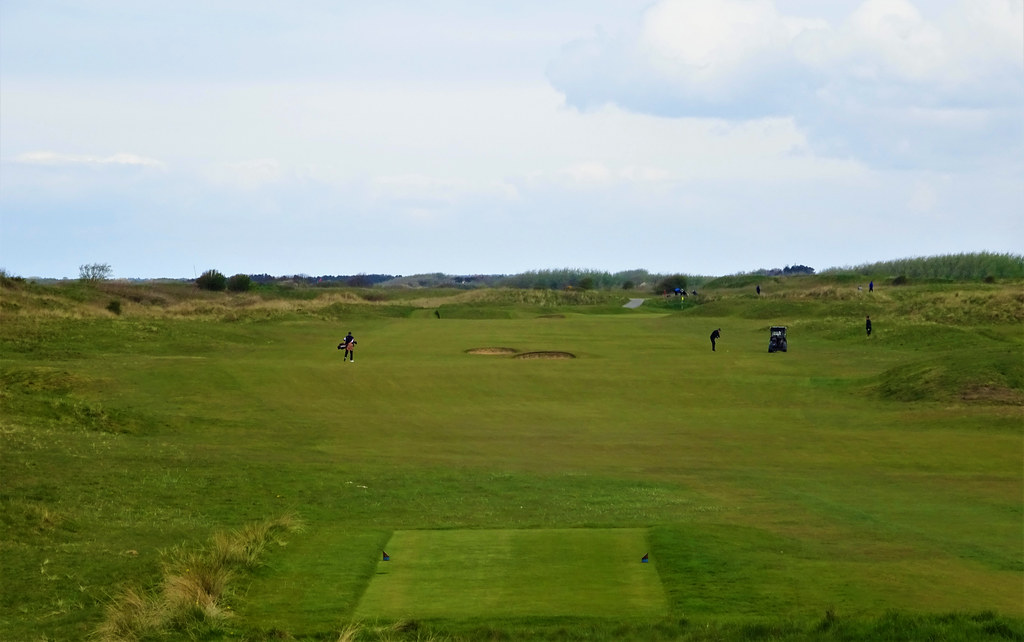
Despite being one of the oldest clubs in England with a long history of hosting prestigious events, West Lancs GC is somewhat shrouded in mystery. Situated in the wonderfully named Blundellsands, perhaps one reason for the lack of fame is due to the origins or near origins of the links not being the handiwork of a famous golfer. 1873 is very early in the architecture timeline, but the names of these primal designers aren’t even recorded. It is thought T Dunn, J Braid and H Hilton may have had their say about the course, but I haven’t found any clues as to what these contributions might have been.
Within 12 years of being founded West Lancs would become a major force in amateur British golf by being one of 24 clubs to contribute toward the purchase of the Amateur Championship Trophy which was first played in 1886. A major amateur event was organized by Royal Liverpool in 1885 which was won by Allan Macfie. In 1922 the R&A decided to retrospectively declare the 1885 tournament the first Amateur Championship. Thus, it became that Macfie was the first winner of the event rather than Horace Hutchinson’s win at St Andrews in 1886. Incidentally, because of halved matches, there were only three semi-finalists and Macfie received a bye into the final!
Harold Hilton is most often associated with Hoylake, but in 1889 he became a member of West Lancs. In 1901 Hilton was appointed the first paid Secretary of the club. In May of that year Hilton successfully defended his 1900 Amateur Championship by pipping John Low one up at St Andrews. These must have been sweet victories after losing three finals in six years during the previous century. However, all wasn’t doom and gloom for Hilton in the 1890s. He won the Open twice, the first in 1892 (one of the years he lost in the Amateur final) and again in 1897 at his home club, Hoylake. However, it can be argued that Hilton’s finest achievements were victories in both the 1911 British and US Amateurs…he was 42! Hilton was the first person to complete the double Amateur and the last Englishman to win the US Amateur until Matthew Fitzpatrick’s 2013 stunning victory at Brookline. Hilton would pop up again and in 1913 cruise to an Amateur win at St Andrews. Soon after WWI would descend upon Europe and golf took a back seat. As if a switch had been flicked, to a man, the pre-war champions fell away from their glory days and were replaced by a younger generation. There can be no doubt that Harold Hilton was one of the greatest of champions in the period between 1890 and 1914.

The old house on the inland side of the rail tracks created a stark and fairly equal divide of flat inland holes and holes in the dunes. Re-siting the house to its present location on the seaward side of the tracks in 1961 opened access to more interesting land in the dunes. Fred Hawtree and CK Cotton are usually attributed as the designers for what strikes me as a highly modern links. There is very little quirk which is a hallmark of the period. Cotton often collaborated as a partner with Lawrie, Pennink or Steel, but not Hawtree so far as I know. Fred Hawtree was seemingly a natural choice to redesign West Lancs as he did work on nearby Birkdale, Hillside and Hoylake. While it would be interesting to know who did what, what matters most is the course we have to enjoy.
The course is layed out as two 9s; the first a clockwise loop back to the house and the second a figure 8. The demanding opening four holes generally play north along a shipping lane of the Irish Sea. While I wouldn't quite say it was winter conditions, a steady 12-15mph north wind under gloomy skies increased the challenge by a considerable degree. The first is a good representation of what to expect. Many holes are played between low dunes over relatively flat fairways. However, that description isn't meant to imply the golf is boring, far from it. The greensites are often one or more of cleverly located, well protected by sand or unusual shapes. Three linear bunkers running down the right send the clear message to drive left. Trying to come in from the right will mean facing a blind shot with hidden bunkers.

Even in the poor light it is clear the green is not without interest.

The rather amateur looking bunkers are more centreline, but the par five second is similar to the 1st.

The short holes may well be the highlight of West Lancs. Aptly named Bowl, the third plays into a protective ring of dunes, but the green is raised. Raised greens with scooped out wings/runaway areas is a central theme of the design.

More to follow.
Ciao